The FlyWire Consortium initiative has achieved a groundbreaking achievement that promises to revolutionize neuroscience research worldwide. The first complete wiring diagram of an adult brain, in case of fruit fly (Drosophila melanogaster)). The authors say the map is accompanied by a series of papers showing that innovation is already leading to new scientific discoveries.
This historic achievement, published in two papers in the journal Nature, is the result of research collaboration between scientists and institutions from different fields such as neuroscience, biology and technology. The researchers work at the MRC Molecular Biology Laboratory, the University of Cambridge (both in the UK) and the American universities of Princeton and Vermont.
Until now, efforts to map brains have been limited to those of the brain’s larvae. DrosophilaA nematode worm with 3016 neurons and 302 neurons. Therefore the newly published diagram, with 139,255 neurons in the adult fly brain, It is the first study involving an animal that can walk and see.
Making a “Google Map” of a fly’s brain
To begin creating the map, the researchers took the entire brain of a female fly, less than a millimeter wide, and sliced it into an impressive seven thousand slices, each about 40 nanometers thick. These strips, previously scanned with a high-resolution electron microscope, were aligned with the help of artificial intelligence (AI) and used for 3D reconstruction of neurons.
But even for AI tools that analyze more than 100 terabytes of image data, extracting the shape of 140,000 neurons and the 50 million connections between them can lead to some errors.
For this reason, according to the statement made, the consortium said, “meticulously examines all data for approximately 33 person-years“. This effort was shared by 287 researchers and teams in more than 76 laboratories around the world, as well as volunteers.
The map also simulates brain functions
A very important step towards Understanding the nervous system means knowing the exact connection of circuits down to the synapse levelhe mentions in one of the articles. This field of knowledge, defined as “connectemics” in neuroscience, is being investigated for the first time in a brain connectivity map, as it aims to predict the function of all connections between neurons.
Neurons use electrical signals to exchange messages among themselves. Each may have hundreds of branches connecting it to its peers. Where these branches meet and transmit signals are synapses. These occur in two main ways: excitatory, which stimulates the persistence of the electrical signal in the receiving neuron, or inhibitory, which reduces the likelihood of the next neuron transmitting the signal.
While the new function diagram is an impressive achievement, we will still have to wait a while, possibly years, for the technology to spread to the human brain, its 86 billion neurons and at least a quadrillion synapses.
Follow the latest developments in science and technology at TecMundo and get the opportunity to share the article on your social networks. Until later!
Source: Tec Mundo
I’m Blaine Morgan, an experienced journalist and writer with over 8 years of experience in the tech industry. My expertise lies in writing about technology news and trends, covering everything from cutting-edge gadgets to emerging software developments. I’ve written for several leading publications including Gadget Onus where I am an author.













